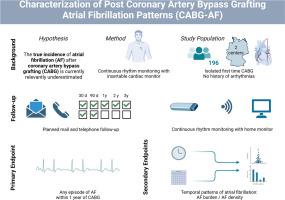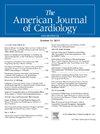冠状动脉旁路移植术后心房颤动模式(CABG-AF)的特征:一项由研究者发起的观察性研究的原理和设计。
IF 2.1
3区 医学
Q2 CARDIAC & CARDIOVASCULAR SYSTEMS
引用次数: 0
摘要
心脏手术后新发的术后心房颤动(POAF)与不良事件(包括死亡率和中风)发生率的增加有关。冠状动脉旁路移植术(CABG)后心房颤动的发生率约为 30%,而且被认为是一种短暂的症状。然而,由于使用了间歇性心律检测策略,对 CABG 术后 POAF 的调查研究未能提供有关发病率和心律失常模式的适当数据。与连续监测相比,这些方法的灵敏度较低。因此,利用这些技术进行的研究很可能无法识别所有心律失常患者,也无法充分展示心律失常的长期发生率,进而可能影响其与不良事件的关联。CABG-AF 研究(德国临床试验注册编号:DRKS00018887)检验了一个假设,即 CABG 术后头 12 个月的房颤发生率被明显低估。CABG-AF 是一项由研究者发起的多中心、前瞻性、观察性研究,在这项研究中,196 名首次接受 CABG 手术且无心律失常病史的患者将接受可插入式心脏监护仪进行术后连续心律监测。研究的主要终点是术后 12 个月内的房颤发作。次要终点包括房颤负担、房颤密度以及无声房颤与有症状房颤发作的比率。终点将通过植入设备的自动和患者主动数据传输、对患者的电话访谈以及通过邮寄给患者的随访表进行调查。计划对患者进行为期 3 年的随访。总之,CABG-AF 研究将提供有关 CABG 术后房颤真实发生率以及心律失常时间模式的信息。本文章由计算机程序翻译,如有差异,请以英文原文为准。

Characterization of Post Coronary Artery Bypass Grafting Atrial Fibrillation Patterns: Rationale and Design of an Investigator-Initiated Observational Study
New-onset postoperative atrial fibrillation (POAF) after cardiac surgery is associated with increased rates of adverse events (including mortality and stroke). Its incidence after coronary artery bypass grafting (CABG) is considered to be approximately 30%, and it is believed to be a transient condition. However, studies investigating POAF after CABG fail to provide appropriate data on incidence and arrhythmia patterns due to the use of intermittent rhythm detection strategies. These methods have a low sensitivity as compared with continuous monitoring. Subsequently, studies using these techniques most likely do not identify all patients with arrhythmia and do not adequately demonstrate the long-term incidence of arrhythmia, which in turn may affect its association with adverse events. The Characterization of Post Coronary Artery Bypass Grafting Atrial Fibrillation Patterns (CABG-AF) study (German Clinical Trials Register Number: DRKS00018887) tests the hypothesis that the incidence of AF in the first 12 months after CABG is significantly underestimated. CABG-AF is an investigator-initiated multicenter, prospective, observational study in which 196 patients with no history of arrhythmia who underwent first-time CABG receive an insertable cardiac monitor for continuous postoperative rhythm monitoring. The primary end point of the study is any episode of AF within the first 12 months after surgery. Secondary end points include AF burden, AF density, and the ratio of silent to symptomatic AF episodes. End points will be investigated by automatic and patient-initiated data transfers from the implanted device, by telephone interview of patients, and by follow-up forms sent to patients by mail. The patients will be followed for a planned follow-up of 3 years. In conclusion, the CABG-AF study will provide information on the true incidence of AF after CABG and on the temporal patterns of the arrhythmia.
求助全文
通过发布文献求助,成功后即可免费获取论文全文。
去求助
来源期刊

American Journal of Cardiology
医学-心血管系统
CiteScore
4.00
自引率
3.60%
发文量
698
审稿时长
33 days
期刊介绍:
Published 24 times a year, The American Journal of Cardiology® is an independent journal designed for cardiovascular disease specialists and internists with a subspecialty in cardiology throughout the world. AJC is an independent, scientific, peer-reviewed journal of original articles that focus on the practical, clinical approach to the diagnosis and treatment of cardiovascular disease. AJC has one of the fastest acceptance to publication times in Cardiology. Features report on systemic hypertension, methodology, drugs, pacing, arrhythmia, preventive cardiology, congestive heart failure, valvular heart disease, congenital heart disease, and cardiomyopathy. Also included are editorials, readers'' comments, and symposia.
 求助内容:
求助内容: 应助结果提醒方式:
应助结果提醒方式:


